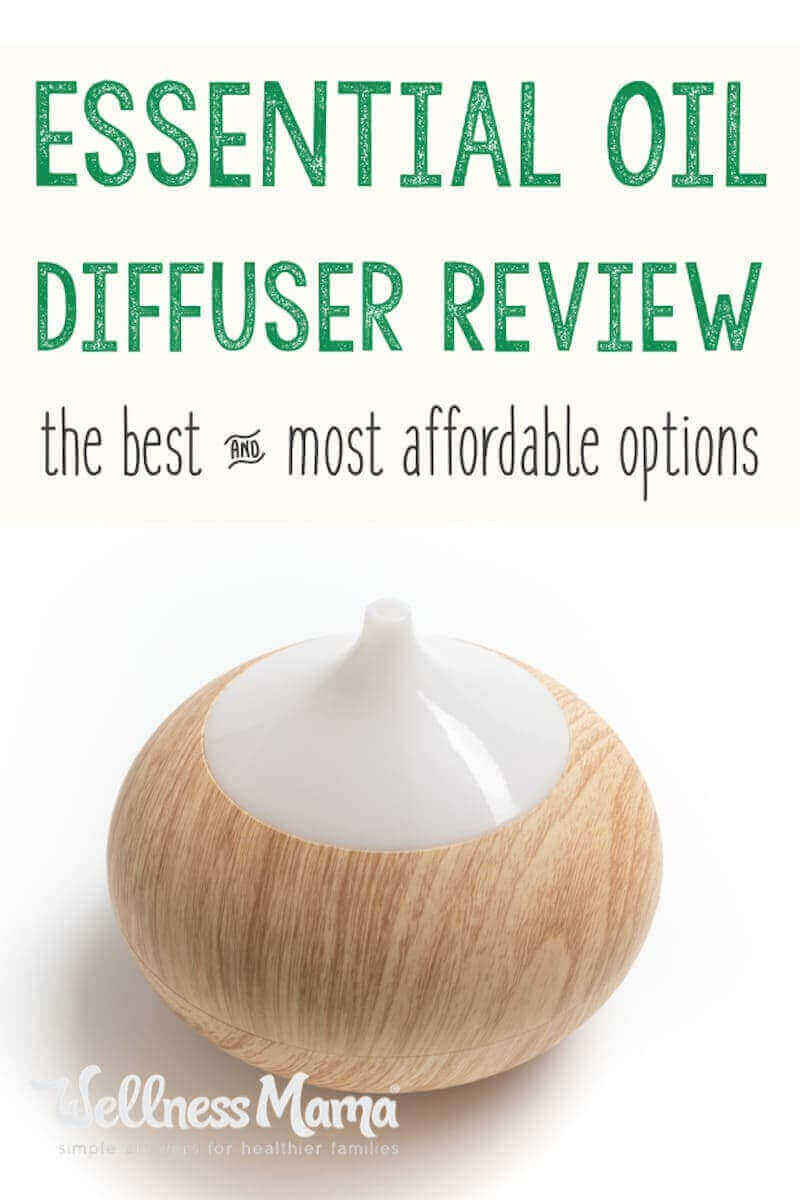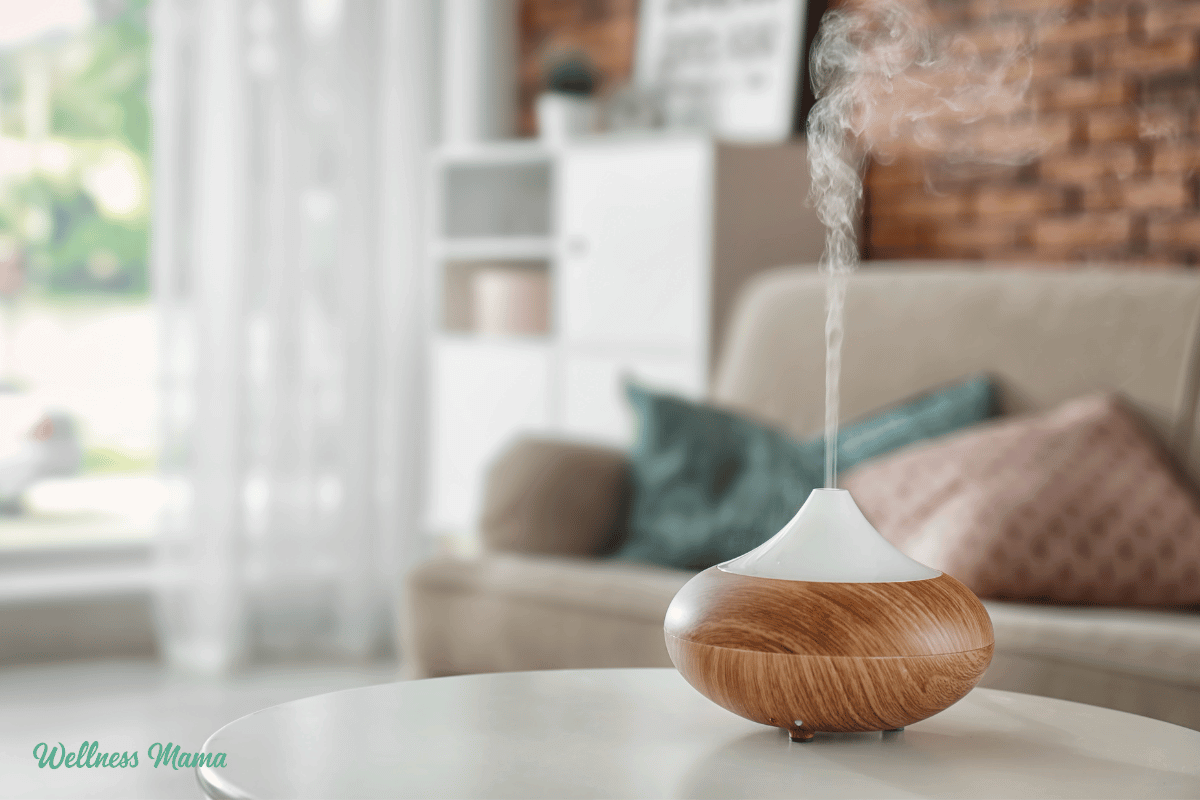I’ve posted before about why we don’t use scented candles and what we use instead. One of my favorite alternatives is essential oil diffusers, and many people asked what type of diffuser I use and recommend.
I’m not an aromatherapy expert, but I have tried many types of diffusers. I wanted to share the pros and cons of the ones we’ve tried. This can help you find a high-quality aroma diffuser that will work well for your own family.
Not all diffusers are created equal and some work much better than others. I wish I’d read a review like this before deciding which to purchase and I hope my experience will be helpful to you.
Benefits of Diffusing Essential Oils
So what does diffusing essential oils mean exactly, and why would you do it? Electric diffusers use various methods to disperse essential oil containing water droplets through the air in a fine intermittent or continuous mist. There are also passive diffusers, like reed diffusers and other waterless diffusers.
Diffusers aren’t just a natural substitute for plug-ins and air fresheners though. Each essential oil has powerful chemical properties from its parent plant. These chemicals bind to our olfactory receptors (how we smell) and affect our limbic system. These nerves in our brains control our hunger, emotions, anger, sleep, and more, so it makes sense diffusing oils can have a real effect.
There are a number of studies (plus a whole lot of anecdotal evidence) that diffusing essential oils can produce the following benefits, depending on the type of oil:
- Reduces stress
- Improves mental clarity
- Uplifts the mood
- Calms and has a soothing effect (useful before sleep)
- Purifies the air
Essential oils are so much more than home fragrances. We need to be cautious about how we use them around our homes and our children.
Best Essential Oil Diffusers
There are a few different types of essential oil diffusers which is one reason why narrowing down to the right one can feel a little overwhelming. Here are some of the different kinds:
- Heat diffusers
- Evaporative diffusers
- Nebulizer diffusers
- Ultrasonic/humidifying diffusers
In addition to researching them, I’ve tried each type of diffuser and have learned what I like and what I don’t about each.
1. Heat Diffuser
A heat diffuser (as it sounds) uses heat to turn water with a few drops of essential oil into a gas that disperses into the air. These can be electric or use the heat of a candle/flame.
I haven’t found a heat diffuser that worked nearly as well as even the worst nebulizer or ultrasonic diffuser I’ve tried. So I can’t make any recommendations on these types of diffusers. Since heat affects the beneficial properties of essential oils, I definitely don’t recommend this method for diffusing oils in general.
They can also be dangerous to use in the home with curious kids or pets who might knock them over. Heat diffusers (especially ones that use a candle) don’t have an automatic shut-off so aren’t safe to use unattended or while sleeping.
2. Evaporative Diffusers
These diffusers use a fan to increase airflow across an essential oil soaked pad or lining. As the liquid evaporates, the scent (and its properties) move into the air.
Another type of evaporative diffuser is diffuser pendant jewelry. The theory is that the essential oil will naturally evaporate and permeate the air and skin. I don’t find this type of diffuser nearly as effective as the remaining two.
Reed diffusers work the same way and can offer a subtle scent if you’re working at a desk or have it right next to you. They’re not good for large rooms or areas.
3. Nebulizing Diffusers
Nebulizing diffusers are often considered the most powerful type of diffusers and with good reason. They don’t need water or heat to get the essential oil into the air. Nebulizing diffusers work by using an atomizer to create fine, airborne particles of essential oils and blowing them into the air.
If you can’t tell, nebulizing diffusers are my favorite type of diffuser. If anyone gets sick they can keep a near-continuous stream of essential oils in the air and can fill a large room of many square feet.
Here’s my experience with this type of diffuser:
Pros:
- Attaches directly to the bottle of essential oil and can be turned on with the flip of a switch
- No water or set-up required
- Strong concentration of essential oils released into the air. Great for large areas like the living room.
- Timers control run time and rest time. Lets you control how long it runs and provides an option other than continuous use.
- No light so they can be used at night since we avoid night lights
Cons:
- The noise level is louder than ultrasonic diffusers
- Uses oils more quickly than ultrasonic or other diffusers since they attach directly to the diffuser
- More expensive than most ultrasonic diffusers (though not by much)
We use: This Advanced Aromatherapy Essential Oil Diffuser from Amazon. I’ve now saved up and ordered a couple of these because they work so well. Even just diffusing for 15 minutes will leave a lasting essential oil scent for hours.
4. Ultrasonic Diffusers
Ultrasonic diffusers work in a similar way to nebulizing diffusers by creating a fine mist. The difference is that ultrasonic diffusers use water and essential oils to create an ultrasonic cool mist of water/oils that releases into the air. They release moisture into the air but not as much as a true humidifier. It can be helpful in the winter if you have it right next to you, but for a stronger humidifying effect you’d need a true humidifier.
Ultrasonic diffusers also don’t put out as strong of a concentration of essential oils since they also use water.
Many ultrasonic diffusers have various light settings and you can choose from different colored LED lights. This isn’t a feature I use, especially at night (here’s why). Some of them you can turn the light off, but that’s not always the case.
You can find tons of inexpensive ultrasonic diffuser sets now even at big box stores, online, and in pharmacies. Many of these can work ok but come with bottles of cheap “essential oils” that are really just fragrance oils. If they’re selling precious oils like sandalwood, jasmine, and rose for just a few dollars a bottle that’s a good way to tell they’re not actually essential oils.
Pros:
- Less expensive than nebulizing diffusers
- Helps humidify the air some (beneficial in cold months)
- Many options to choose from
- Don’t use heat
- The water tank has a large capacity
Cons:
- Need water to operate
- Must be cleaned occasionally
- Some have lights that can’t be turned off
- Not as effective as nebulizing diffusers
What we use: Several different types of ultrasonic diffusers and I’ve found that some work better than others. These were our favorites:
- The Noor Litemist Aromatherapy Diffuser – This simple cone-shaped design diffuses for several hours and has an option to turn the light on or off for nighttime use. (Just please don’t use any LED color-changing lights at night… here’s why!)
- The Allay Litemist Diffuser – Very similar and slightly cheaper than the Noor Litemist. It doesn’t seem to have a way to turn off the light which makes it unusable at night (for us).
- Portable Car Diffuser – I’ve tried smaller models but got tired of repeatedly filling their tiny water reservoirs! This one does take up a cupholder but I like the intermittent/constant control and the sleek design. It also comes with Plant Therapy’s Travel Essential Oil Blend, has a USB charger, and can run off of battery power.
Other Ways to Freshen Indoor Air
Essential oils are a great way to freshen indoor air with natural scents but they’re definitely not the only way! We keep our indoor air clean naturally with:
- Indoor plants to filter the air – A NASA study found that plants were effective at filtering out VOCs and other indoor air toxins.
- Salt Lamps, Beeswax Candles, and Charcoal Bags – Three simple ways to clean indoor air without needing a diffuser or essential oils. They don’t offer a natural scent like oils do, but they can remove harmful compounds from the air.
- Air filters. With the number of toxins in indoor air, air filters are a necessary and beneficial step. I explain why we love ours (we have several) here. You’ll want to be sure to not run an essential oil diffuser right next to an air filter that’s on. The air filter will just filter the essential oils out of the air.
Bottom Line: Choosing The Best Essential Oil Diffuser
Essential oils may seem like mix-and-match perfumes, but in reality, they are powerful essences from plants with medicinal effects. Using a diffuser is a great step, but everyone should do their homework. If you have a family, make sure to diffuse only kid-safe essential oil blends and take breaks by using a model with intermittent mist settings.
If you have pets in the home it’s important to safely diffuse around them too. Birds are very sensitive to the volatile oils and most experts say not to diffuse around them at all. You can read more about how to safely diffuse around pets (and when to avoid) here.
This article was medically reviewed by Madiha Saeed, MD, a board certified family physician. As always, this is not personal medical advice and we recommend that you talk with your doctor.
Have you ever used a diffuser? What did you like or not like about it? Share below!



Leave a Reply